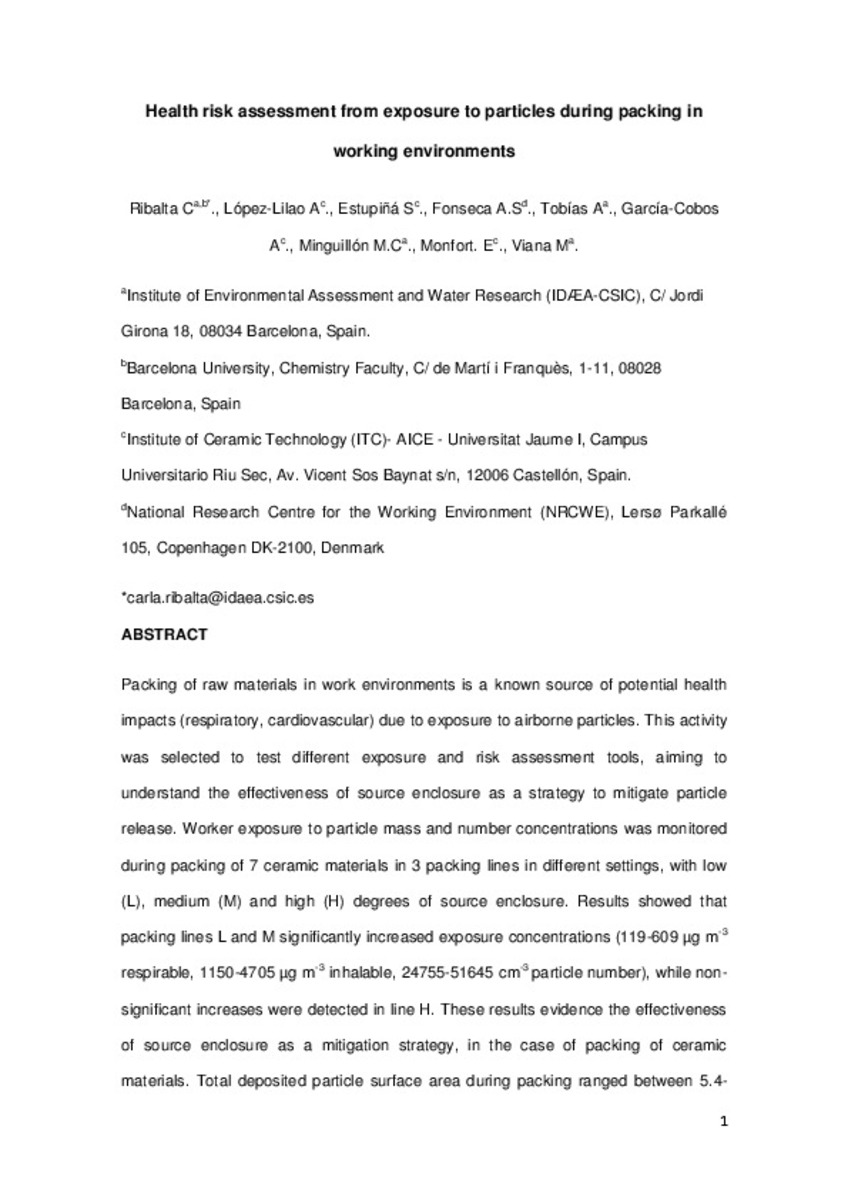Mostrar el registro sencillo del ítem
Health risk assessment from exposure to particles during packing in working environments
| dc.contributor.author | Ribalta, Carla | |
| dc.contributor.author | López Lilao, Ana | |
| dc.contributor.author | Estupiña, S. | |
| dc.contributor.author | Fonseca, A.S. | |
| dc.contributor.author | Tobías, A. | |
| dc.contributor.author | García-Cobos, Aroa | |
| dc.contributor.author | Minguillón, María Cruz | |
| dc.contributor.author | Monfort, Eliseo | |
| dc.contributor.author | Viana, Mar | |
| dc.date.accessioned | 2019-09-17T17:55:07Z | |
| dc.date.available | 2019-09-17T17:55:07Z | |
| dc.date.issued | 2019-06-25 | |
| dc.identifier.citation | RIBALTA, Carla, et al. Health risk assessment from exposure to particles during packing in working environments. Science of The Total Environment, 2019, vol. 671, p. 474-487 | ca_CA |
| dc.identifier.issn | 0048-9697 | |
| dc.identifier.issn | 1879-1026 | |
| dc.identifier.uri | http://hdl.handle.net/10234/183795 | |
| dc.description.abstract | Packing of raw materials in work environments is a known source of potential health impacts (respiratory, cardiovascular) due to exposure to airborne particles. This activity was selected to test different exposure and risk assessment tools, aiming to understand the effectiveness of source enclosure as a strategy to mitigate particle release. Worker exposure to particle mass and number concentrations was monitored during packing of 7 ceramic materials in 3 packing lines in different settings, with low (L), medium (M) and high (H) degrees of source enclosure. Results showed that packing lines L and M significantly increased exposure concentrations (119-609 μg m-3 respirable, 1150-4705 μg m-3 inhalable, 24755-51645 cm-3 particle number), while nonsignificant increases were detected in line H. These results evidence the effectiveness of source enclosure as a mitigation strategy, in the case of packing of ceramic materials. Total deposited particle surface area during packing ranged between 5.4-11.8x105 μm2 min-1, with particles depositing mainly in the alveoli (51-64%) followed by head airways (27-41%) and trachea bronchi (7-10%). The comparison between the results from different risk assessment tools (Stoffenmanager, ART, NanoSafer) and the actual measured exposure concentrations evidenced that all of the tools overestimated exposure concentrations, by factors of 1.5-8. Further research is necessary to bridge the current gap between measured and modelled health risk assessments. | ca_CA |
| dc.format.extent | 68 p. | ca_CA |
| dc.format.mimetype | application/pdf | ca_CA |
| dc.language.iso | eng | ca_CA |
| dc.publisher | Elsevier | ca_CA |
| dc.relation.isPartOf | Science of The Total Environment, 2019, vol. 671, p. 474-487 | ca_CA |
| dc.rights | Attribution-NonCommercial-NoDerivatives 4.0 Internacional | * |
| dc.rights.uri | http://creativecommons.org/licenses/by-nc-nd/4.0/ | * |
| dc.subject | exposure | ca_CA |
| dc.subject | non-communicable disease | ca_CA |
| dc.subject | workplace | ca_CA |
| dc.subject | human health impacts | ca_CA |
| dc.subject | modelling | ca_CA |
| dc.subject | ventilation | ca_CA |
| dc.title | Health risk assessment from exposure to particles during packing in working environments | ca_CA |
| dc.type | info:eu-repo/semantics/article | ca_CA |
| dc.identifier.doi | https://doi.org/10.1016/j.scitotenv.2019.03.347 | |
| dc.relation.projectID | This research was founded by the Spanish MINECO (CGL2015-66777-C2-1-R, 2-R), Generalitat de Catalunya AGAUR 2017 SGR41, the Spanish Ministry of the Environment (13CAES006), and FEDER (European Regional Development Fund) “Una manera de hacer Europa”. Additional support was provided by caLIBRAte project funded by the European Union's Horizon 2020 research and innovation programme under grant agreement No 686239. M.C. Minguillón acknowledges the Ramón y Cajal Fellowship awarded by the Spanish Ministry of Economy, Industry and Competitiveness. | ca_CA |
| dc.rights.accessRights | info:eu-repo/semantics/openAccess | ca_CA |
| dc.relation.publisherVersion | https://www.sciencedirect.com/science/article/pii/S0048969719313452 | ca_CA |
| dc.date.embargoEndDate | 2021-06-25 | |
| dc.type.version | info:eu-repo/semantics/acceptedVersion | ca_CA |
Ficheros en el ítem
Este ítem aparece en la(s) siguiente(s) colección(ones)
-
QUI_Articles [296]








